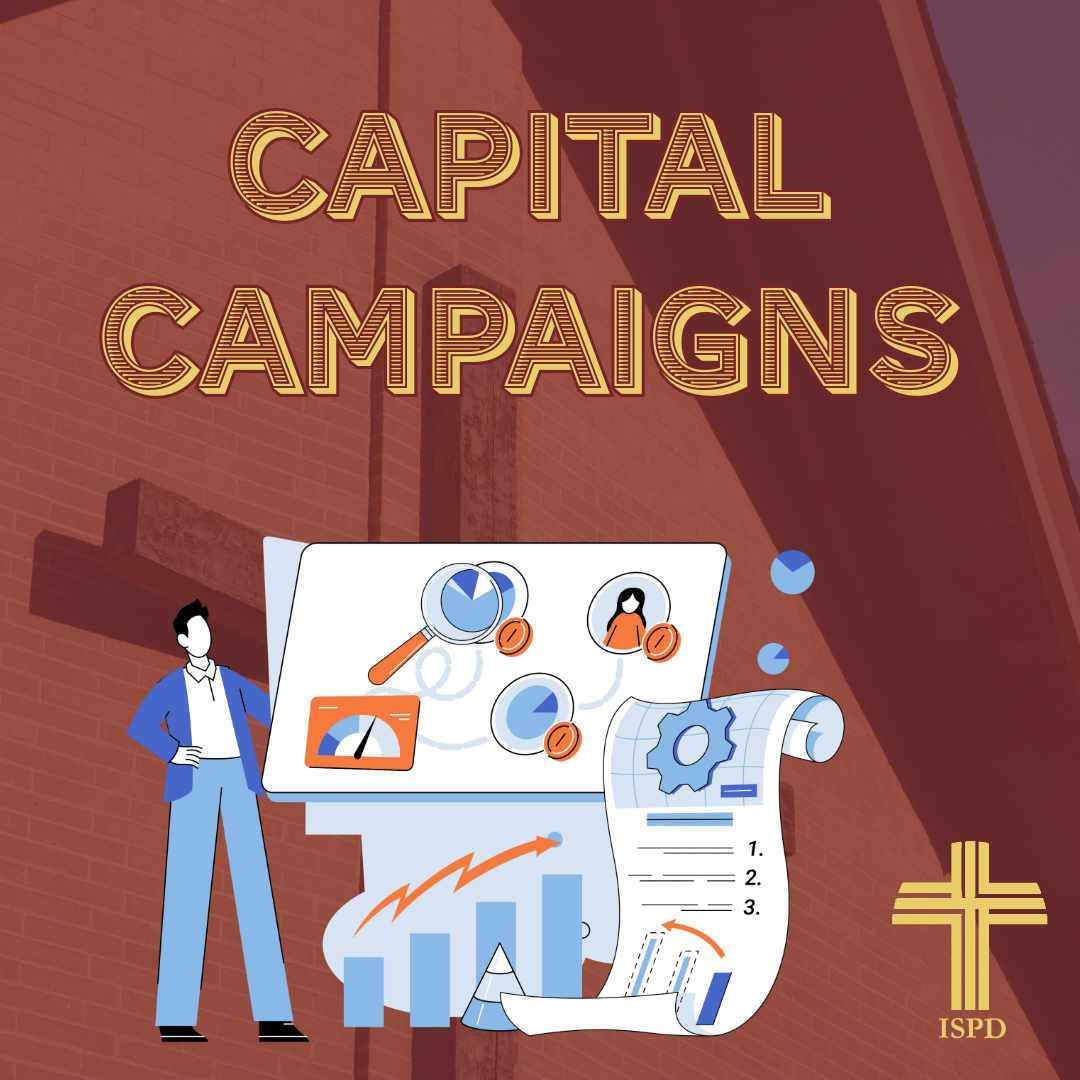- A full functioning database;
- Successful enrollment management processes;
- A comprehensive total stewardship process;
- Active and on-going alum involvement;
- Systemic communications using many platforms and avenues;
- Effective fund/friend-raising events;
- Solid people engagement efforts;
- Successful annual giving;
- Capital campaign preparation and/or initiation;
- Individualized new parishioner welcome process;
- Consistent financial leader identification, relationship-building, and invitation;
- Organized strategic plans of action;
- Plus, others.
Like an automobile, without these components (parts) being present, or without them functioning at full capacity, your Catholic school and/or parish may not operate as well as it can, or at worst, may leave you stranded on your journey toward successful Operational Vitality.
Here at ISPD, we have spent the past ten months listening, interacting, surveying, presenting, consulting, teaching, and coaching. Over 2,000 Catholic leaders have participated in, read, or been part of our Monday cohort sessions, our Friday Zoom sessions, our seven national surveys, our SPECIAL EDITION newsletters, our national round tables, our monthly podcasts, our on-line courses for Catholic schools and parishes with the University of Dayton’s Institute for Pastoral Initiatives, and OUR SHINING MOMENT video on Catholic schools. From all these activities, which still continue in 2021, we have observed and learned so much.
Through it all, it is remarkable the progress that many Catholic schools and parishes have made since March 2020. To simplify — if that is even possible — we may be able to put our school and parishes into three categories:
- Pro-active: Surging ahead with creative, innovative, positive, mission-driven leadership on all levels;
- Active: Moving forward but somewhat hesitant, yet able to maintain a certain degree of quality – not all leadership groups being on the same page and/or included;
- Re-active: Somewhat stalled and not moving forward with creativity – waiting on the “powers to be” to tell them what to do and how to do it.
During these times, we find that most Catholic schools and parishes that fall into the first two categories have one thing in common: they seek ways to engage people and build their community. Yet, one of the main questions we have heard over the past few months is this: have we built a solid-enough foundation for our development—advancement—stewardship—enrollment management — communication efforts to sustain themselves over time? Going back to the top paragraph, do we have enough of the main components (parts) in place for this vehicle to go the distance from the end of 2020 and into the summer of 2021? And, how can we continue to add people fuel to our development vehicle?
This newsletter is titled: USING EFFECTIVE PROCESSES AND TOOLS TO BUILD A SOLID DEVELOPMENT FOUNDATION DURING THIS PANDEMIC, PART III. With the November 2020 newsletter, the December 2020 newsletter, and this one in January 2021, we offer 30 foundational processes that we recommend Catholic schools and parishes consider over the next 6-8 months. We are not saying that all of these should be “taken on” at once; there are those that will best fit your needs and your culture and those that would not be applicable to where you are now. Some are for schools, and some are for parishes, and many are for both. Many of these are processes that ISPD is now coaching in our new Partnership Coaching Portal. (www.ispdpartnerships.com)
In Part III let’s look at 10 more foundational processes (and tools to use) for effective Catholic Development—Advancement—Stewardship.
Process # 21: Review Annual Fund organizational structure and materials.
- Whom to Involve: Executive Committee (talked about in Part I, November 2020 newsletter – this could be Administration – pastor, president, principal – and development/advancement/stewardship officer, and/or board/council chair, and/or chair of Development/Stewardship Core Team, and/or financial leader. This group has the main decision makers and school/parish leaders who are directly involved with the development—advancement—stewardship efforts. Usually 4-6 people).
- Tools to Use: ISPD’s Annual Fund Organization – in 25 Lessons Learned book (Lesson 17) which is available from NCEA + ISPD Annual Fund Checklist which can be requested from ISPD at catholicdev@ispdconsulting.com.
- Outcomes/Value: With six months left in the fiscal year, January is the perfect time to check on your Annual Fund and see how it is doing. The key here is to make sure to involve many of the people mentioned above.
Process # 22: Create Catholic school/school family expectations.
- Whom to Involve: Executive Committee
- Tools to Use: This process addresses the value of having a clear set of expectations (5-10) that a family can expect from the school and, conversely, the school can expect from a family.
- Outcomes/Value: Establishes expectations and can take a school from being re-active to family involvement to pro-active.
Process # 23: Create Pastor/President/Principal Cabinet.
- Whom to Involve: Executive Committee
- Tools to Use: In 15 More Lessons Learned book (Lesson 9) which is available from NCEA + ISPD newsletter which can be requested from ISPD at catholicdev@ispdconsulting.com.
- Outcomes/Value: With the widespread use of virtual meetings, creating a Cabinet during this pandemic is not as difficult as you may believe. This does give administrators the opportunity to create challenges they face and seek solutions from people in their community and beyond.
Process # 24: Enlist and organize Ambassador Teams for Enrollment Management.
- Whom to Involve: Executive Committee with Enrollment Management/Admissions personnel
- Tools to Use: Open discussion with EC members on which Ambassador Teams to have in place: Student, Parent, Alumni and/or Parish. Develop invite list and 5-10 bullet points for roles and responsibilities. View Lesson 15 in 25 Lessons Learned – available through NCEA.
- Outcomes/Value: These Ambassador Teams build critical mass and allow more messengers to share the same message. It is important to have the Top 10 Selling Points and the WOW.
Process # 25: Set up one-on-one virtual visits with school teams and parents.
- Whom to Involve: Executive Committee and Faculty/Staff
- Tools to Use: View Lesson 7 in 25 Lessons Learned book from NCEA.
- Outcomes/Value: Allows school leaders the opportunity to build strong relationships and a win-win culture with families – in a personal manner.
Process # 26: Conduct parish surveys: in-pew, on-line, and hybrid.
- Whom to Involve: Executive Committee
- Tools to Use: ISPD People Engagement Survey for parishes. Join as an Affiliate Partner (free) in the new ISPD Partnership Coaching Portal and we will send you the survey upon your request. We will also send you The Ultimate Question Survey to use. In our book, Total Parish Development, available through ISPD, Lesson 9 outlines conducting parish surveys. Or, use recommended (arch) diocesan surveys.
- Outcomes/Value: Allows the parish to constantly “pipeline” to parish families – find out how they feel, what they are challenged by, how the believe things are going, etc.
Process # 27: Understand case points for Annual Fund and Capital Campaigns.
- Whom to Involve: Executive Committee
- Tools to Use: Open discussion to determine not only needs growing out of strategic plans but also what donors are now interested in funding in the middle of this pandemic
- Outcomes/Value: Donors want to support something specific and tangible. In the Annual Fund, rather than asking for support of the operational budget, seek funding for specific items in a Gift Catalog. In a capital campaign, ask donors to support items growing out of the school/parish strategic plan.
Process # 28: Educate on preparing and presenting a State of the Parish and/or State of the School message.
- Whom to Involve: Executive Committee
- Tools to Use: Open discussion on what to say and when to present. During these times, many parishes and schools have promoted monthly and/or quarterly presentations from the pastor, the president, and/or the principal. Agenda items can be updates, good news, challenges, future steps, guidelines, and ways to become involved. Can be done via Zoom, GoToWebinar, or other on-line platforms.
- Outcomes/Value: During these uncertain times, this type of messaging keeps people informed and also allows parish and school leaders to be “out front.”
Process # 29: Organize and conduct listening/input sessions.
- Whom to Involve: Executive Committee
- Tools to Use: Refer to 25 Lessons Learned (Lesson 10) book available from NCEA. Or, e-mail catholicdev@ispdconsulting.com and we will send a document explaining Input Sessions.
- Outcomes/Value: Similar to conducting surveys, this allows school leaders to keep their fingers on the pulse of attitudes and opinions. In today’s world, this can be conducted via virtual platforms.
Process # 30: Organize and conduct Parish Assembly/Town Hall.
- Whom to Involve: Executive Committee
- Tools to Use: Through EC discussions, schedule regular Town Hall meetings (in-person with social distancing or virtual) on a quarterly basis. Agenda can be: 1. Opening Prayer; 2. Updates; 3. Good news; 4. Challenges parish is facing; 5. Invitation for input; 6. Future steps; 7. Closing Prayer
Outcomes/Value: This allows parish leaders the opportunity communicate on a consistent basis and in a personal manner.[/vc_column_text][/vc_column][/vc_row]















